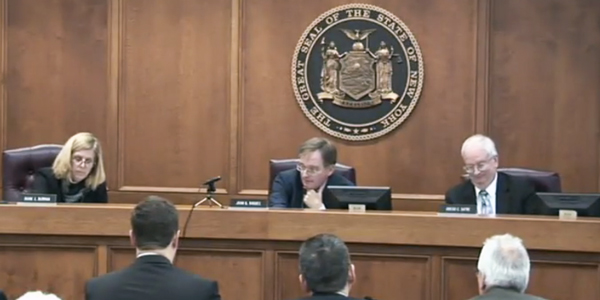By Michael Kuser
At its final meeting of the year, the New York Public Service Commission approved rules to implement community choice aggregation, a pilot program to reduce air conditioning loads and a waiver allowing an energy service company (ESCO) to market to low-income customers.
Utility Energy Registry
The PSC on Thursday approved fees, procedures and data privacy protection measures for the Utility Energy Registry, an online platform to provide information regarding customer energy use. The order requires utilities to file tariff amendments implementing CCA data fees effective Jan. 6, 2018 (14-M-0224).
Access to such information is vital to the success of the distributed energy resources market, the commission said; for CCA programs to function, municipalities and program administrators must be able to access both aggregated and individual customer data.
The order directs that customers pay one-half of the estimated cost to prepare queries to populate the registry, with the remainder recovered from fees for customer lists and customized aggregated data. The costs to be recovered via CCA fees will be based on an estimated request rate of 25% of eligible customers over five years.
“Through the creative bargaining power enabled by the community choice aggregation model, communities are enabled to work with their energy supplier to procure resources that better serve their citizens’ local energy goals,” PSC Chair John Rhodes said. “This order provides a fair and uniform approach to an essential point of enabling CCAs to go forward: an approach on data fees. It will accelerate the opportunity for communities who wish to establish a CCA.”
The commission set a fee of 80 cents per account for all utilities, saying that obtaining the mailing list and the ability to engage in an opt-out program will help CCAs and ESCOs minimize customer acquisition costs.
Con Edison Smart A/C Trial
The commission also voted to approve a three-year, $7.5 million pilot program for Consolidated Edison to control its New York City customers’ air conditioners to help shave peak demand in summer. Customers who allow the utility to install Wi-Fi-enabled ‘smart plugs’ on their A/C units will be eligible to earn $95 or more in rebates and rewards.
While some 21,000 electricity customers already participate in Con Ed’s Smart AC program, the commission’s order on the new pilot program, Connected Devices, expands the demand response measure to millions of people, including public housing tenants (17-E-0526).
New York City Housing Authority residents get their electricity from the New York Power Authority and do not pay the monthly adjustment clause (MAC) surcharge through which the programs’ costs are recovered. Commissioner Diane Burman asked how expanding the measure to NYPA customers would affect the cost-recovery mechanisms approved by the commission.
“We anticipate the impact of any cost shifts from NYPA to Con Edison customers to be minimal while participation and penetration of these programs is low in the NYPA buildings,” responded Robert Cully, a Department of Public Service staffer.
Con Ed estimates there are 450,000 residential units in the buildings supplied by NYPA, a significant source of untapped load relief. The utility could petition for additional cost recovery, “and Con Edison is not shy about requesting those sort of program modifications,” Cully said.
ESCO Low-income Ban Waiver
The commission gave Utility Expense Reduction permission to serve low-income customers, ruling that the company had fulfilled the waiver requirements of its December 2016 order prohibiting ESCOs from enrolling customers who are participants in low-income assistance programs.
The PSC requires that ESCOs demonstrate an ability to calculate what the customer would have paid to the utility; an assurance that the customer will be paying no more than what they would have paid to the utility; and proper reporting and verification to ensure compliance. (See New York PSC Adopts DER Rules, Sanctions ESCOs.)
The order (12-M-0476) requires the ESCO to report semiannually on the participation of low-income customers in its Green Energy Price Cap Program. The company must report “the number of customers served, the monthly calculated amounts billed and the alternative amounts that the utility would have charged by customer, as well as the amount of any refunds issued to each customer to effectuate the price guarantee,” the commission said.
Burman voted against the waiver. “I’m concerned about doing these individually in standalone petitions and would rather see a more collaborative process that gets to a more global solution in a more standardized way,” she said.
Year-End Performance Wrap

Before adjourning, Rhodes took the opportunity to summarize the major actions by the commission and the Cuomo administration in 2017. Among the highlights: a Con Ed rate ruling intended to encourage energy efficiency and smart grid technologies; the announced closure of the Indian Point nuclear plant; a new compensation structure for valuing DERs; an order allowing large commercial batteries in New York City; an expansion of Con Ed’s Brooklyn-Queens Demand Management project; and a solar project for low-income customers.
“So it has been a productive year,” said Rhodes, the former CEO of the New York State Energy Research and Development Authority, who was appointed to the commission in June to replace Audrey Zibelman. (See NYPSC Chair Promises ‘Continuity’ on State Energy Policies.)
The commission ended the meeting by approving a resolution of appreciation to Tina Palmero, deputy director of the DPS’ Office of Clean Energy, who is leaving the department. Rhodes said that Palmero joined the department as a transmission specialist in 1988 and that her work over the years, including on the state’s Clean Energy Standard, has had “tremendous impact to the benefit of all New Yorkers.”







